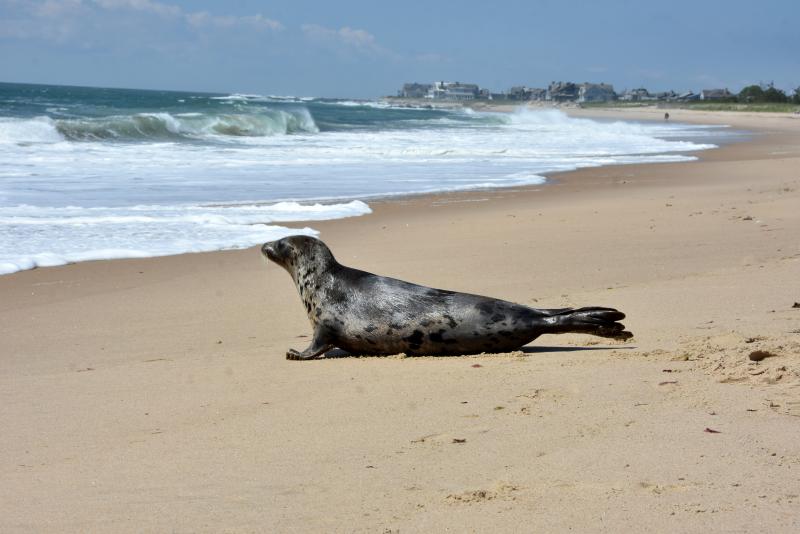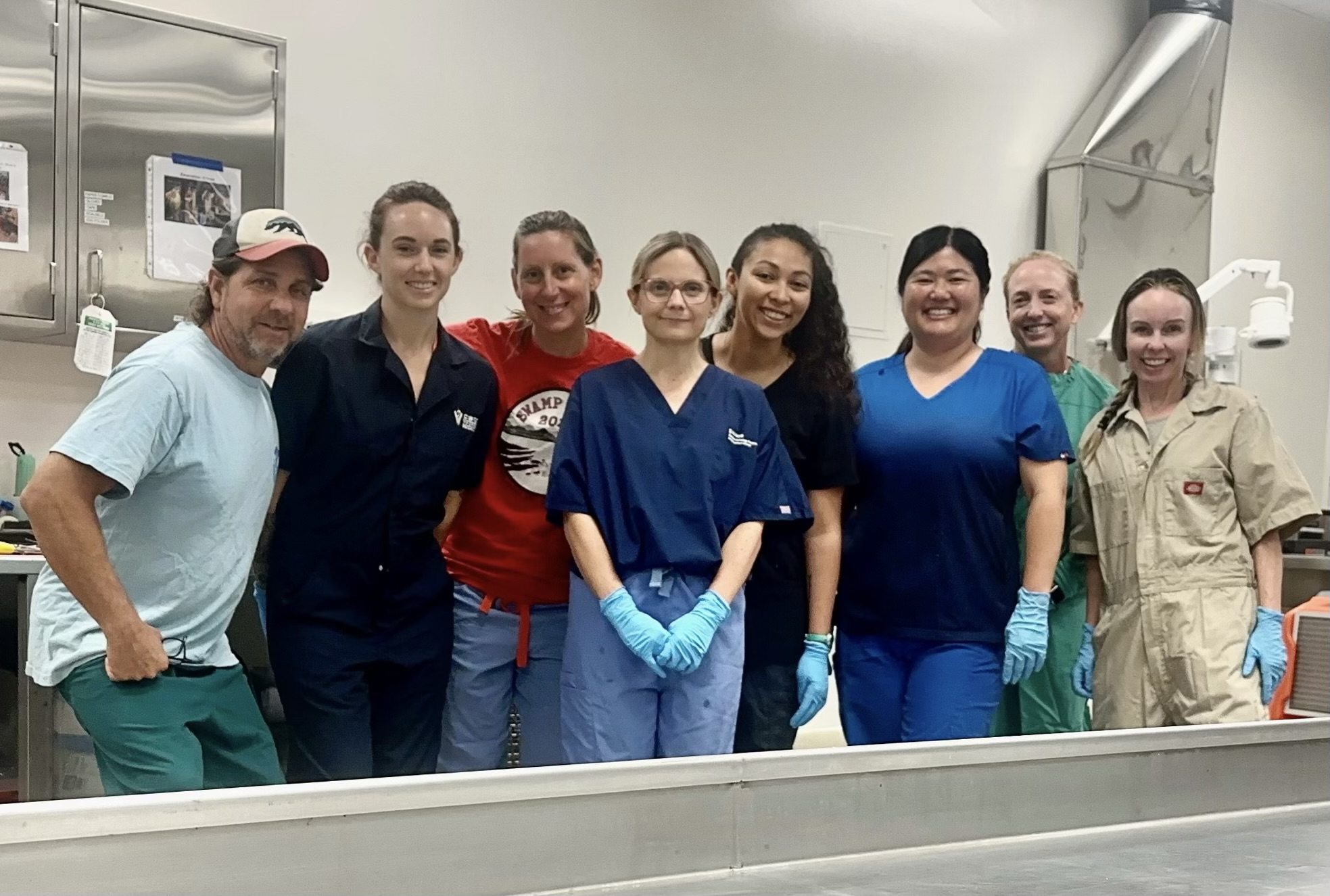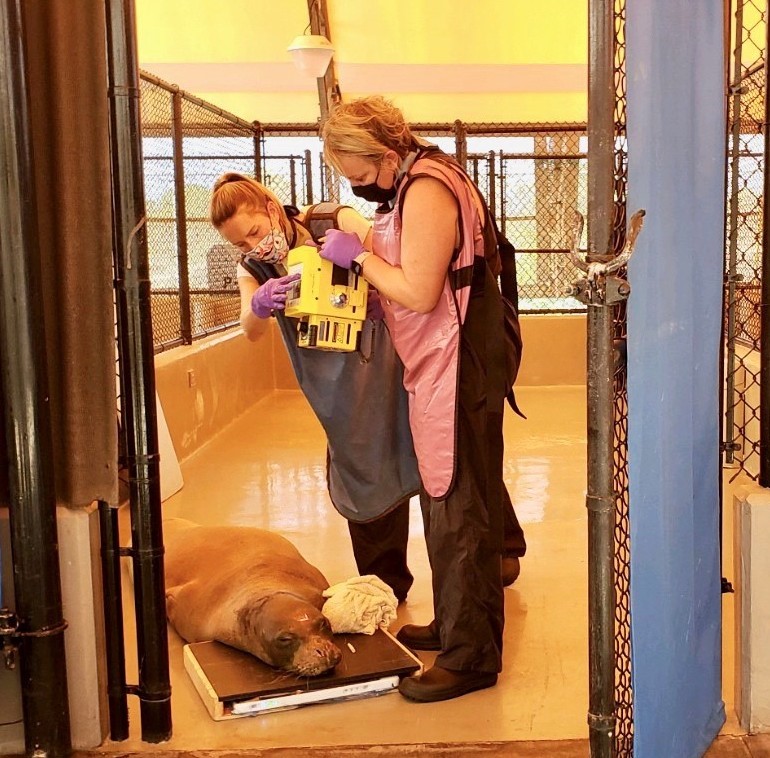The John H. Prescott Marine Mammal Rescue Assistance Grant Program provides funding to stranding network participants. It allows them to better respond to marine mammal strandings, improve capacity, and conduct scientific investigations into the causes of stranding events. Since 2001, the program has awarded more than $75.4 million.
We are proud to highlight the recent accomplishments of organizations that used Prescott Grant funds to respond to and conserve seal and sea lion populations. They are found throughout most of the United States, although they are less abundant in the Southeast. Pinnipeds are important sentinels of aquatic health. Their well being is reflective of natural and human-caused threats in aquatic ecosystems. NOAA Fisheries authorizes these organizations to save sick and injured seals and sea lions, and investigate their health by examining live and dead stranded pinnipeds.
National: University of Illinois Marine Mammal Diagnostic Service
The Marine Mammal Diagnostic Service at the University of Illinois, College of Veterinary Medicine is a comprehensive pathology and molecular diagnostic service. For more than 15 years, the laboratory has provided critical pathogen testing to network members across the country.
Each year the Marine Mammal Diagnostic Service performs close to 1,500 diagnostic tests on marine mammal samples. The lab tests for pathogens such as Brucella, phocine distemper virus, and herpesvirus. A Prescott grant in 2022 supported the creation of a new diagnostic test for Brucella. The diseases caused by these pathogens can weaken and kill marine mammals. In rare cases, these pathogens can spread between species to also infect pets or humans. Better understanding these diseases supports routine necropsy cases and Unusual Mortality Event investigations to identify the cause of death.
This important work is led by veterinary pathologist and professor, Dr. Katie Colegrove. In 2023, Dr. Colegrove led an advanced necropsy training workshop in Hawaii with NOAA Fisheries’ Hawaiian Monk Seal Research Program. It covered evaluating animals for human-caused trauma and infectious diseases, such as toxoplasmosis, which is one of the biggest threats to the species. Through this workshop, participants improved their ability to identify illness and injury in Hawaiian monk seal carcasses. This knowledge is important in determining cause of death and understanding the threats to this endangered species.
In 2022 and 2023, the University of Illinois received two Prescott grants totalling $178,494. They provided a total match amount of $72,544.
“The Prescott grant program has provided critical salary support for the technical staff that complete molecular testing for marine mammal pathogens,” said Dr. Colegrove. “This funding enables our program to provide rapid testing for important marine mammal pathogens increasing our understanding of the role that disease plays in pinniped populations.”
Greater Atlantic Region: Marine Mammals of Maine
Marine Mammals of Maine responds to seal strandings along 2,500 miles of Maine’s coastline, including remote islands along the state’s southern coast from Kittery to Rockland. The organization works in response, rehabilitation, outreach and education, and research. One of their most important outreach activities is educating the public about respectful and responsible viewing practices of seals, particularly during Maine’s busy tourist season.
To ensure adequate response coverage throughout the Greater Atlantic Region, Marine Mammals of Maine provides rehabilitation for animals rescued in Maine and other states. It also supports other network partners—including College of the Atlantic, Seacoast Science Center, and the International Fund for Animal Welfare—that do not have seal rehabilitation capabilities. They also conduct pinniped health assessment monitoring in the Northwest Atlantic working with many other stranding network partners.
In 2022, Marine Mammals of Maine—along with their stranding partners, and state and federal agencies—responded to an Unusual Mortality Event involving harbor and gray seals along the coast of Maine. The UME was attributed to spillover events of the highly pathogenic avian influenza H5N1 virus from infected birds to seals. The event involved 181 seals—including 143 harbor seals, 28 gray seals, and 10 seals of unidentified species.
From 2020 to 2023 Marine Mammals of Maine received Prescott grants totalling $399,723 in federal funding. The organization provided matching funding for these awards totalling $283,726.
“Prescott has helped support so many aspects of our organization to build capacity. The biggest impact is supporting our organization to have the foundation to be the boots on the ground answering the call for animals in need that are reported along Maine’s coastline,” said Executive Director Lynda Doughty. “We know it is not about saving every animal, but helping the ones that need help, especially since they don’t have a voice to do so.”
Pacific Islands Region: The Marine Mammal Center, Ke Kai Ola Hawaiian Monk Seal Hospital
The Marine Mammal Center is the world’s largest marine mammal hospital. Since 1975, they have rescued more than 24,000 marine mammals along the coast of California and in Hawaii. The main hospital and headquarters in Sausalito, California responds to stranded marine mammals along 600 miles of coastline from Mendocino County to San Luis Obispo County. The second center, Ke Kai Ola Hawaiian Monk Seal Hospital, is located in Kona, Hawai’i. Ke Kai Ola responds to and rehabilitates stranded Hawaiian monk seals. This hospital is the only long-term care facility for the endangered Hawaiian monk seal. It admits stranded monk seal patients from across the 1,500 mile Hawaiian archipelago.
From 2020 to 2023, Ke Kai Ola Hawaiian Monk Seal Hospital received Prescott grants totalling $392,030. The facilities also contributed grant match amounts totalling $382,923. Associate Director, Hawai’i Conservation Medicine Dr. Sophie Whoriskey, states, “Thanks to a recent Prescott award, we were able to purchase a new X-ray machine to replace our ailing older machine. This piece of equipment has proved critical in identifying life-threatening hook ingestions in our Hawaiian monk seal patients. With fishery interactions being a leading cause of death for Hawaiian monk seals in the main Hawaiian Islands, this funding was crucial to ensure this life-saving diagnostic tool continues to be readily available.”
West Coast Region: Ocean Animal Response and Research Alliance
The Ocean Animal Response and Research Alliance investigates the cause of death for marine mammals that wash ashore in Los Angeles County. Before this organization was created, many seal and sea lion carcasses were buried or dragged out to sea before they could be thoroughly examined. Now, scientists can better assess the threats to marine mammals in the area. From 2020–2024, the organization documented nearly 200 dead stranded seals and sea lions.
In 2023, Ocean Animal Response and Research Alliance assisted in the investigation of animals that died during the 2023 domoic acid event in Southern California. During this large-scale harmful algal bloom event, the organization responded to 80 carcasses in 40 days. They collected and submitted important samples to effectively document the extent of the event.
From 2021 to 2023, Prescott Grant Program awarded Ocean Animal Response and Research Alliance grants totalling $219,112, for which they provided a total match amount of $73,148.
"As a new, upstart non-profit providing mortality response and investigations in Los Angeles County, without the Prescott funding, Ocean Animal Response and Research Alliance would not have been able to exist and maintain growth,” said Keith Matassa. “Funding from the Prescott Grant was critical for Ocean Animal Response and Research Alliance to gain traction and grow this program over the past 3 years.”
Alaska Region: Alaska SeaLife Center
Since 1998, Alaska Sealife Center has been rescuing, rehabilitating, and examining live and dead marine mammals. The Center is located in Seward, Alaska and is the only marine mammal rehabilitation facility in Alaska. It admits animals that have stranded throughout all of Alaska’s 33,000 miles of shoreline, which is more shoreline than the continental United States.
Given Alaska’s vast wilderness, more than 20 stranding network partners—including universities, tribal communities, and local governments—work to recover and transport many of the stranded live animals admitted to the Center for rehabilitation.
In 2023, the Alaska SeaLife Center hosted their third workshop about remote marine mammal stranding response, which included participation by the Seldovia Village Tribe. Participants were trained in assessing animals in the field, data collection, and live animal triage and transport. These workshops are critical to ensure effective marine mammal stranding response throughout Alaska. The Center can’t respond to every animal on their own, so partnership of local communities is critical to strengthen the response ability of the wider Alaska stranding network.
From 2021 to 2023, the Prescott Grant Program provided awards totalling $280,083 in federal funding. The Alaska SeaLife Center provided total matching funds of $93,892.
“The NOAA Prescott Grant Program offers essential support for the Wildlife Response department at the Alaska SeaLife Center. Thanks to the grant, we are able to employ animal care staff year-round, support housing for interns, and train reponse partners,” said Jane Belovarac, Alaska SeaLife Center’s Wildlife Response Curator, “It's helped the SeaLife Center become a reliable resource in Alaska for marine mammal stranding response.”





